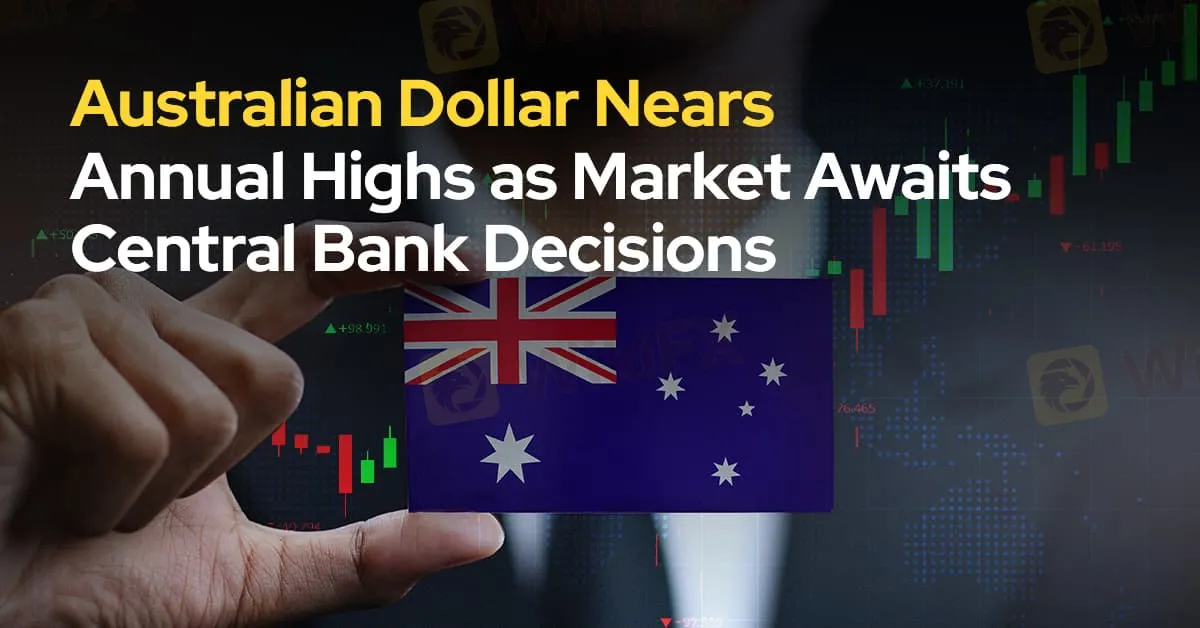简体中文
繁體中文
English
Pусский
日本語
ภาษาไทย
Tiếng Việt
Bahasa Indonesia
Español
हिन्दी
Filippiiniläinen
Français
Deutsch
Português
Türkçe
한국어
العربية
Australian Dollar Nears Annual Highs as Market Awaits Central Bank Decisions
Abstract:According to a report, the Australian dollar edged close to its highest point this year, trading at $0.6839 after a solid 0.45% increase.

According to a report, the Australian dollar edged close to its highest point this year, trading at $0.6839 after a solid 0.45% increase. This rise coincides with the Reserve Bank of Australia (RBA) expected to hold interest rates steady, prompting traders to speculate on any signals regarding potential easing. Among 44 economists surveyed, only four foresee a rate cut by December, while traders estimate a 60% likelihood.
The currency's strength is bolstered by recent stimulus measures from the People's Bank of China (PBoC), including a 50 basis point reduction in banks' reserve requirements, which contributed to a slight dip in the yuan. Initially, the yuan fell by 0.16% in offshore trading but later stabilized around 7.0590 per dollar. Markets analyst Tony Sycamore noted that once the RBA's meeting concludes, the Aussie might rally towards 70 cents by the end of the year.
Meanwhile, the Japanese yen remained stable at 143.495 against the dollar as traders anticipated insights from Bank of Japan Governor Kazuo Ueda regarding future interest rate adjustments. The euro, recovering from a nearly 0.5% decline driven by lackluster business activity surveys, was holding steady at $1.1105. Sterling, too, remained near a 2-1/2-year high at $1.33445, supported by the Bank of England's careful approach to potential rate cuts.
In summary, central bank policies and economic trends are pivotal in shaping the current currency landscape, creating an atmosphere ripe for volatility in the markets.

Disclaimer:
The views in this article only represent the author's personal views, and do not constitute investment advice on this platform. This platform does not guarantee the accuracy, completeness and timeliness of the information in the article, and will not be liable for any loss caused by the use of or reliance on the information in the article.
Read more

Geopolitical Events: What They Are & Their Impact?
You've heard many times that geopolitical events have a significant impact on the Forex market. But do you know what geopolitical events are and how they affect the FX market? Let us learn about it today.

Why Do You Feel Scared During Trade Execution?
Trade execution is a pivotal moment for traders. It is when analysis turns into action, and potential profits or losses become reality. However, for many traders, this moment is accompanied by fear. Why does this happen, and how can you address it?

WikiEXPO Global Expert Interview: Simone Martin—— Exploring Financial Regulation Change
In the midst of financial innovation and regulation, WikiGlobal, the organizer of WikiEXPO, stays abreast of industry trends and conducts a series of insightful and distinctive interviews on pivotal topics. We are delighted to have the privilege of inviting Simone Martin for an in-depth conversation this time.

Doo Financial Expands Reach with Indonesian Regulatory Licenses
PT. Doo Financial Futures, a subsidiary of the global financial services brand Doo Group, has secured regulatory approval from Indonesia’s Badan Pengawas Perdagangan Berjangka Komoditi (BAPPEBTI).
WikiFX Broker
Latest News
Volkswagen agrees deal to avoid Germany plant closures
Geopolitical Events: What They Are & Their Impact?
Top 10 Trading Indicators Every Forex Trader Should Know
WikiEXPO Global Expert Interview: Simone Martin—— Exploring Financial Regulation Change
TradingView Launches Liquidity Analysis Tool DEX Screener
MultiBank Group Wins Big at Traders Fair Hong Kong 2024
'Young investors make investment decisions impulsively to keep up with current trends' FCA Reveals
Why Do You Feel Scared During Trade Execution?
CySEC Settles Compliance Case with Fxview Operator Charlgate Ltd
Malaysian Influencer Detained in Taiwan Over Alleged Role in Fraud Scheme
Currency Calculator


